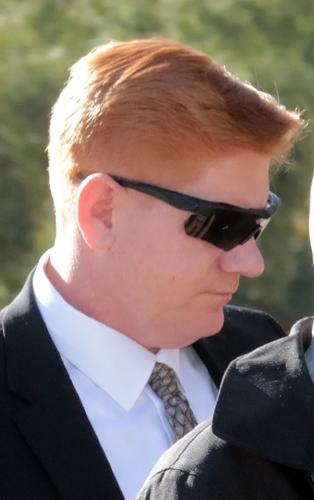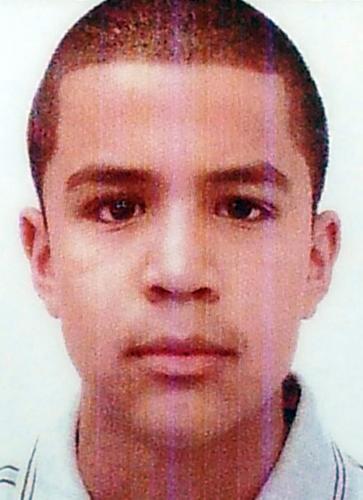Jurors will have options as they deliberate whether Border Patrol Agent Lonnie Swartz is guilty of a crime for shooting through the border fence and killing Jose Antonio Elena Rodríguez. While the indictment was for second-degree murder, on Monday the judge instructed jurors to consider voluntary and involuntary manslaughter if they can’t reach a verdict on the more serious charge.
The defense and the prosecution rested their cases Monday in federal Judge Raner Collins’ courtroom in Tucson after about four weeks of testimony from agents and officers at the scene of the Oct. 10, 2012, shooting in Nogales, and by expert witnesses.
For prosecutors, the fact that Swartz fired 16 shots in 34 seconds, hitting Elena Rodríguez 10 times in the back and head, shows he did it with “malice aforethought,” or reckless disregard for human life.
But to the defense, Swartz was justified in his use of force in response to a group of people — including Elena Rodríguez — throwing rocks from the Mexican side to help two alleged drug smugglers on top of the fence flee into Mexico. Smugglers are known to be armed and to become combative if they need to protect a load, Swartz’s attorneys argued.
But Swartz is not God, “He can’t decide who lives or dies,” Assistant U.S. Attorney Wallace Kleindienst told the jury, regardless of whether Elena Rodríguez was throwing rocks.
The night Swartz killed 16-year-old Elena Rodríguez, it was not about “eliminating a threat, but about eliminating a human being,” Kleindienst said. The prosecutor argued the reason Swartz shot from a second and third location was not because he saw a second rock thrower, as Swartz testified, but because he was still seeing movement as the teen “was fighting for his life on the ground.”
Border Patrol agents have a difficult job and “We owe them gratitude,” Kleindienst continued in his closing argument, “but they are like us, imperfect human beings and can’t use their badge as a shield or license to commit murder.”
Rocks can be dangerous, Kleindienst told the jury, but not all rocks are the same and agents are trained to assess the situation and use lethal force as a last resort. In this case, most of the rocks recovered at the scene were smaller pieces of concrete and the rock throwers were about 90 feet away. Swartz was behind a 22-foot fence over a 14-foot cliff on the Mexican side. The rock throwers “were trying to cause distraction so their compadres could get off the fence,” the prosecutor said, not trying to kill the agents on the other side, whom they couldn’t see.
Swartz always seemed to approach “rockings” with force, instead of seeking cover. He was fed up and angry at rock throwers and determined to stop the threat that night no matter what, Kleindienst said.
But the defense argues agents are trained from the very beginning that rocks can be lethal no matter their size and are allowed to respond with deadly force if necessary.
The fact that Swartz had used non-lethal weapons in response to this kind of incident in the past shows he would have avoided using deadly force that night in 2012 if he had been able to, the defense argued. Swartz was working at the nearby port of entry and did not have a pepper ball launcher or a similar non-lethal weapon that night.
“Does that make him a hothead? Someone who is ‘fed up’?” defense attorney Sean Chapman asked the jury. “I don’t think so,” and there was no evidence of that, he said.
Chapman also told the jury that the reason his first witness contradicted herself on the stand shows the reality of where she lives. The woman, a Nogales, Arizona, resident identified only as A.O., claimed she saw Elena Rodríguez run by her house near the border that night, but later denied having said that. She has drug smugglers running by her house day and night, Chapman said, and she’s afraid.
In one of his presentation slides, Chapman had in all caps, “THEY ARE TRYING TO MANIPULATE YOU,” in reference to the government’s evidence and expert testimony. While his experts found limitations of the science and weaknesses of the available evidence, the government’s witnesses had “pushed, pushed, pushed,” he said, trying to stitch together their theory and “put a square peg in a round hole.”
Another point of contention has been whether the teenager died from one of the first shots Swartz fired or later, as the agent moved along the fence and fired a second time, stepped back to reload and fired again.
The government’s expert witness concluded one of the first shots was to the back and that Elena Rodríguez was likely alive for most of the other shots. Kleindienst used his body to show the jury how the 16-year-old possibly fell forward and how he extended his arm and moved his head.
Chapman also mimed before the jury, saying that theory was not possible, and instead presented his expert witnesses’ theory of the fatal shot to the head being one of the first fired.
Chapman urged the jurors to use their common sense and to focus on the evidence that was the most persuasive.
Whether Elena Rodríguez was alive or not while Swartz continued to shoot matters for both sides to prove whether he acted maliciously or not, one of the qualifications for second-degree murder.
For the defense, if the jury believes that to be the case, it makes the rest of the shots legally irrelevant. “It would end the case right there because legally,” Chapman said, “he was authorized to do what he did.”
For the defense, it’s really important, Kleindienst said in rebuttal, “because he then doesn’t have to explain why he put another nine shots into that body. Why his client continued to shoot at a body on the ground. I guess it’s OK if he fired into a dead body.”
A conviction of involuntary manslaughter would not be appropriate, Kleindiest told the jury. He equated it to someone who had gotten drunk at a bar and decided to drive home instead of calling Uber, running a red light and killing someone.
“That’s not the case here,” he said.
And voluntary manslaughter, in the heat of passion, would be the equivalent of someone catching his wife in bed with someone else and shooting at him.
In this case, Kleindienst argued, Swartz walked calmly to the fence, left cover and was deliberate in his actions, despite Swartz’s testimony that he had to make a split-second decision and elected to defend himself and his fellow law officers that night.
“He can’t admit to himself (what he did) because it’s an act that’s so horrendous,” Kleindienst told the jury. “Much less admit it to you.” And Swartz’s not remembering much of what happened after he started shooting “is not a memory gap,” the prosecutor said, “it’s an honesty gap.”
But to Chapman it’s “plain wrong” to demonize Swartz, an agent acting based on what he perceived and doing the best he could. “Unfortunate someone died, but you cannot find him guilty of anything because he was acting based on his training.”







